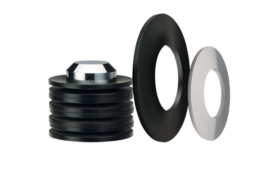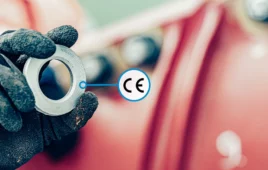Written by Jody Muelaner

A selection of locking and vibration resistant washers. From left to right: Star lock washer with internal teeth, external tab washer, split washer, a stack of opposing Belleville washers, and a stack of interlocked Belleville washers.
Lock washers and vibration-resistant washers are designed to prevent a threaded fastener from loosening. The terms are often used interchangeably. However, there is a difference.
Lock washers resist torque or loosening for a given preload, and vibration-resistant washers maintain a more constant preload when there’s movement in a joint. A lock washer may include some teeth to increase friction or tabs to provide positive locking. A vibration-resistant washer, on the other hand, will be sprung so that as the joint moves, a relatively consistent preload is maintained on the fastener.
Gerhard Junker devised a number of tests for vibration-induced loosening in threaded fasteners.
Some examples of lock washers which increase friction for a given preload include:
- Star washers may have internal or external teeth, they provide quite a small resistance to loosening.
- Tab washers have a tab that can be bent up against the flat of a hex nut or bolt head to provide a positive lock to prevent rotation. To provide a fully positive lock, a two tab washer is required with one tab locking against a feature on the part and the other against the flat on the fastener head or nut.
- Nord-Lock washers are used in a pair, each washer has serrations on one bearing face and cams on the other face. The pair of washers are combined so that the cams face each other. The serrations are intended to indent into the part and nut, preventing rotation. The cams then mean that any loosening with increase the extension of the fastener.
Some examples of vibration resistant washers which are sprung to maintain a more consistent preload are:
- Wave washers are disc-shaped washers that have been pressed to create a wave pattern so that they act as a spring when compressed along the axis of the threaded fastener. They are relatively lightweight, producing quite low preload forces.
- Split washers or helical spring washers, work in a similar way to a wave washer. Some claim that they provide a locking action by digging into the bearing faces but, in reality, these are typically too hard for this to produce any noticeable effect. Wave and split washers generally bottom out at such low forces that they provide very little vibration resistance.
- Belleville washers, conical spring washers or cupped spring washers, these are disc-shaped washers that have been pressed into a conical shell to create a very compact spring. They can generate considerable preload forces and be combined in a number of ways to adjust the preload characteristics. If they are stacked in the same direction, they fit inside each other to increase the spring stiffness, while when stacked in opposing orientations they increase the range of motion. Patters of interlocking and opposing washers can produce high spring force with a large range of motion and the spaces between the washers provide a reliable indication of preload.
An alternative to using a lock or vibration-resistant washer is to use thread-locker or a lock nut. Lock nuts may either use friction, such as a nyloc, distorted thread or jam nut, or they may use positive locking, such as a castellated or slotted nut.





Tell Us What You Think!